ASTROPHYSICS: The formation of the solar system, it's evolution and the evidence of the accretion model.
steemstem·@emperorhassy·
0.000 HBDASTROPHYSICS: The formation of the solar system, it's evolution and the evidence of the accretion model.
<p><br></p><div class="text-justify"> Hello, readers. This post is a sequel to my last post on Astrophysics: The physics of astronomical objects. You can pls click this [link](https://www.steemstem.io/#!/@emperorhassy/astrophysics-the-phy-1556206989) to quickly read through it. Doing that will enable our journey through this post to be smooth sailing. Thanks! <center>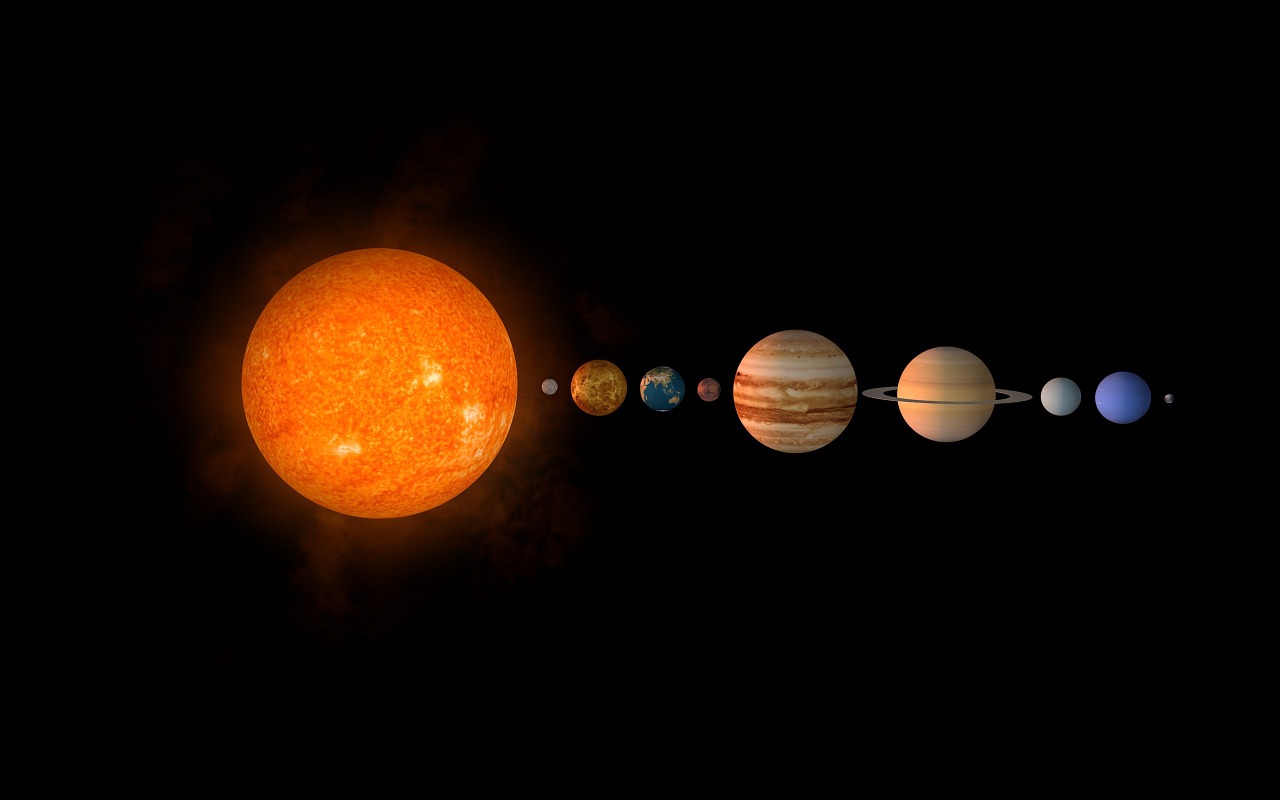</center> <center><sup>Solar system [Pixabay, Valera; CC0](https://pixabay.com/illustrations/sun-planet-solar-system-cosmos-1506019/)</sup></center> <h4>So, let's ride on......... </h4> The Milky Way contains a great deal of material that absorbs light and is often hard to detect. But it may be lit up by nearby stars. This shows a region of dark material in the constellation of Orion, an example of a nebula made of gas and dust, lit up by stars hidden behind it with others in front. The <i>gas</i> is identified from both its visible spectrum and radio spectrum as being mostly hydrogen. The interaction of the <i>interstellar dust</i> with light suggests that it is made of small grains of 'dirty ice', <p>Notice the two bright blue stars in the centre and below the centre on the right. Their colour indicates that they are very new stars, as are many others in this nebula.</p> <p>The account that follows is thought to be broadly the way that the Sun and the planets of the Solar System were formed from both gas (mostly hydrogen with some helium) and dust, as well as the way in which other planetary systems now being found in our galaxy were formed.</p> <center>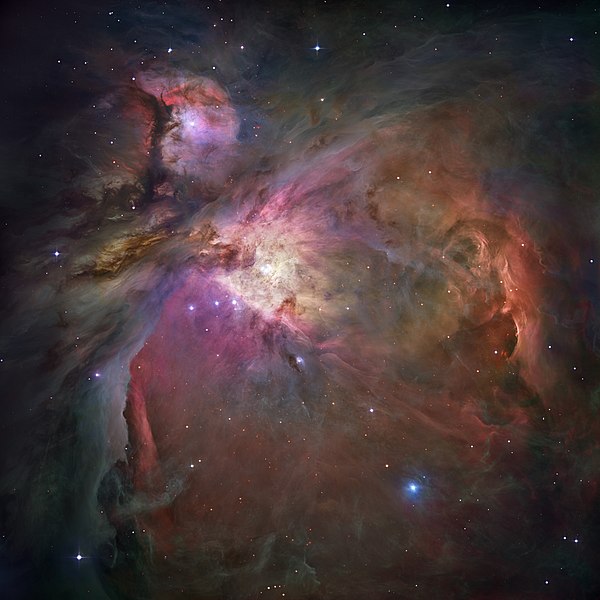</center> <center><sup>The entire Orion Nebula in a composite image of visible light and infrared; taken by Hubble Space Telescope. [NASA, ESA, M. Robberto (Space Telescope Science Institute/ESA) and the Hubble Space Telescope Orion Treasury Project Team • Public domain](https://commons.m.wikimedia.org/wiki/File:Orion_Nebula_-_Hubble_2006_mosaic_18000.jpg#mw-jump-to-license)</sup></center> <h3><center>THE FORMATION OF A STAR</center></h3> To produce a star the size of the Sun would require a (roughly spherical) cloud of dust and gas a few light years in diameter. In the star's formation, much of the material is lost and doesn't end up in the star. The cloud may be stable for billions of years. During this time, the gravitational forces that tend to make it clump together are offset by the random thermal motion of the particles. Then the cloud starts a <b>gravitational collapse</b>. This may be triggered by a disturbance which makes a part of the cloud more dense than the rest. <h3>Phase 1: gravitational contraction of the gas cloud</h3> When the cloud starts to contract under gravity, gas and dust fall towards the centre of mass, gaining speed as potential energy is converted to kinetic energy. Collisions make the extra motion random. The gas gets hotter. Most energy remains trapped, but the cloud begins to lose energy as infrared radiation. At this point, we could detect the cloud from Earth as an infrared source. <center>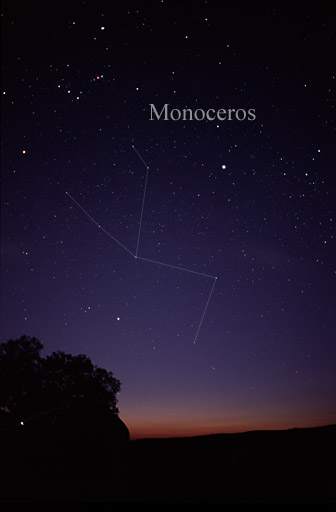</center> <center><sup>The constellation Monoceros as it can be seen by the naked eye. [Wikimedia, Till Credner; CC BY-SA 3.0](https://commons.m.wikimedia.org/wiki/File:MonocerosCC.jpg#mw-jump-to-license)</sup></center> <p>Eventually, the core in the contracting cloud becomes white hot, but we cannot see it because the cooler outer layers absorb the radiation. Because infrared radiation is less easily absorbed, we observe the large dark cloud as a strong source of radiation, an infrared 'hot spot'. </p><h3>Phase 2: a protostar is born</h3> From the start of collapse, it takes about a million years for a mass to reach the stage of being a <b>protostar</b>. The core is several times larger than the star it will eventually become, and its heat generates an outflow of particles which blows away the gas and dust in the cloud that still surrounds it. <p>The hot core is now visible as a pre-main sequence star. It continues to gain energy by a slow gravitational contraction. The material in the core is now a plasma, with all the atoms (mostly protons from hydrogen) stripped of their electrons. </p> <h3>Phase 3: a real star at last</h3> After another 50 million years or so, the core is suddenly at a high enough density and temperature - about 10 million kelvin - to tap a new source of energy: nuclear fusion. Some protons now fuse together, eventually forming helium, in the proton-proton chain, a process called ['hydrogen burning'](http://hosting.astro.cornell.edu/academics/courses/astro201/hydrogen_burn.htm). Vast quantities of energy are suddenly released as the core becomes a nuclear fusion reactor. The energy increases the temperature even further and hydrogen burning extends to more of the core. <center>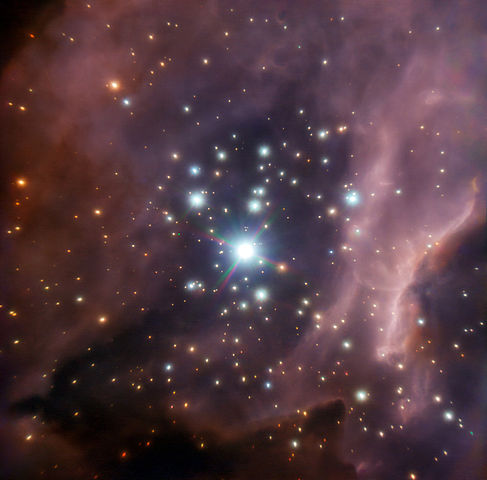</center> <center><sup>Stellar cluster RCW 38, around the young star IRS2, a system of two massive stars and protostars. [Wikimedia, ESO • CC BY 3.0](https://commons.m.wikimedia.org/wiki/File:ESO-IRS2.jpg#mw-jump-to-license)</sup></center> <h3>The star reaches equilibrium</h3> The cloud stops collapsing when the kinetic energy of the particles at all levels is great enough to balance the inward pull of gravity. Compare this with what happens in the Earth's atmosphere: the thermal energy of the air molecules makes them move fast enough not to be pulled to the surface by the Earth's gravity field. <center>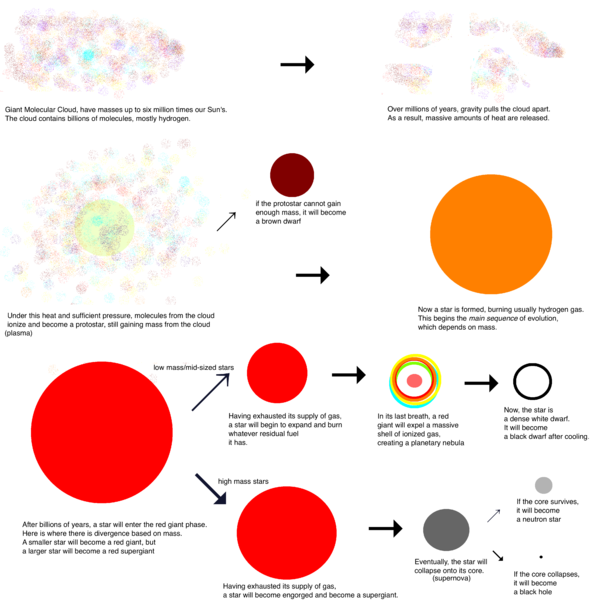.png)</center> <center><sup>Simplistic representation of the stages of stellar evolution [Wikimedia, BedrockPerson; CC BY-SA 4.0](https://commons.m.wikimedia.org/wiki/File:ESO-IRS2.jpg#mw-jump-to-license)</sup></center> <h3><center>THE FORMATION OF PLANETS AND THE INEVITABILITY OF SPIN</center></h3> But while these dramatic events are going on in the core, the gas cloud itself is also changing. <h3>Making a disc</h3> All objects in the Milky Way - indeed in all galaxies - rotate about the centre of mass of the galaxy. Think about our original dusty nebula, It gradually changes from a large mass to one with an axis. The outer edge moves faster than the inner edge, so the nebula spins very slowly on its axis: it has its own <i>angular momentum</i> about this axis. <p>Now think of a mass of atoms, molecules and dust at a distance <i>r</i> from the centre of the nebula: it is rotating about the centre of the nebula at a very low speed <i>v</i>, and has angular momentum <i>mvr</i>. As the nebula contracts, this angular momentum is conserved, that is, <i>mvr</i> stays constant. Its mass <i>m</i> stays the same, but the mean value of <i>r</i> gets less, so speed <i>v</i> must increase. The result is that the shrinking cloud spins faster and faster.</p> <p>Some of the gravitational force pulling the material inwards provides the centripetal force for the spinning mass. Less force is available to pull the particles inwards, so the rate of contraction is less than it would be if the cloud were not spinning. But this effect applies only to the direction at right angles to the axis of spin. There is no spinning along the spin axis, so the cloud condenses more rapidly in this direction. In <b>condensation</b>, small dust particles form when atoms and molecules clump together. The cloud eventually flattens into a pre-planetary disc.</p> <p>We now have another possible equilibrium, when the rotational speed of dust and gas particles is just large enough to keep them in orbit. The gravitational pull of the new central star at the distance of the particles matches the centripetal force needed at that speed. </p> <h3>Making planets</h3> The dust grains are not moving in neatly ordered orbits. They have a large random motion and collisions still happen. The particles stick together to form clumps, a process called <b>accretion</b>. As the clumps get larger they are more likely to bump into others, so they get even larger. At a particular size, a clump is large enough for its gravitational attraction to become significant i.e it has become a <b>planetesimal</b>, and it's able to attract smaller particles to make even bigger object. <p>As time goes on, the larger planetesimals grow even larger by accretion of smaller ones, eventually undergoing contraction and reaching the size of a planet.</p> <p>With the formation of new planets, there is intense heating when bodies make inelastic collisions with each other, and their kinetic energy becomes the internal energy of random motion of their particles. In the Solar System it is likely that at least the rocky planers became hot enough for their cores to be molten. This caused the separation of the planetary material into layers of different chemical structure and density.</p> <p>The Sun and the planets were formed roughly at the same time. The Sun is estimated to be about 5 billion years old (5 × 10<sup>9</sup> y). Radioactive dating shows that the oldest rocks of the Earth and Moon are about 4.6 billion years old.</p> <center></center> <center><sup>The time frame of the Solar System's formation has been determined using radiometric dating. [Wilimedia, Oliverbeatson • Public domain](https://commons.m.wikimedia.org/wiki/File:Solar_Life_Cycle.svg#mw-jump-to-license)</sup></center> <p>Not everyone agrees with this model as the origin of the 'hot Earth'. It is likely that the main reason that the Earth was hot soon after its formation is the existence of radioactive isotopes. Remember that the half life of uranium-238 is about equal to the age of the Earth. This means that at its formation the Earth had twice as much U-238 as it does now. It also contained much more of the shorter-lived radioactive isotopes, such as potassium-40, U-235, etc. What remains of these isotopes is the main source of geothermal energy today, even when their abundance is so much less.</p> <h3>Evidence for the accretion model</h3> There is not much evidence for the model of planetary formation just described, but all the rocky planets and many satellites have large impact craters which were made after the surface had cooled down and solidified. Such craters are harder to find on Earth because of its active geology (plate tectonics), its eroding atmosphere and the fact that two-thirds of its surface is covered by water. <center>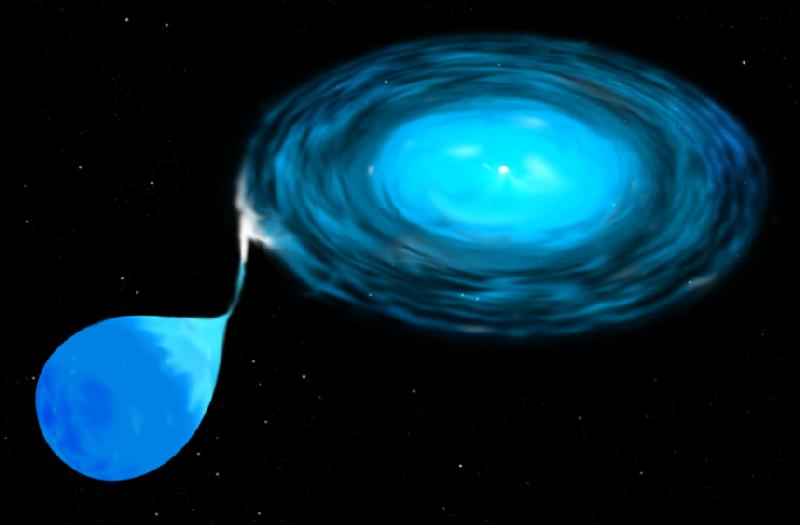</center> <center><sup>Accretion Disk Binary System: When the lower-mass star in a binary system enters an expansion phase, its outer atmosphere may fall onto the compact star, forming an accretion disk. [Wikimedia, STScI; public domain](https://commons.m.wikimedia.org/wiki/File:Accretion_Disk_Binary_System.jpg#mw-jump-to-license)</sup></center> <h4>The reason there are two main groups of planets in the solar system</h4> Now think about the early stage of condensation, accretion and contraction. The new Sun created a large temperature gradient in the nearby surrounding cloud. Near the Sun, only those materials with a high melting could solidify, such as rocks and metals with melting points above 400 or 500 Kelvin. Further out it would be cold enough for water ice to form out - and even further out it would be cold enough to freeze compounds like methane and elements like hydrogen, oxygen and argon. <p>Gas particles are light and easy to move. The Sun emits not only radiation but also a stream of particles called the <b>solar wind</b>, containing protons and electrons. Both the radiation and the solar wind exert forces on particles near the Sun, and tend to push the lighter ones furthest.</p> <p>It is assumed that this process began while the Sun was a protostar. The more massive particles of rock and metal were separated from the gases as rocks and metals formed planetesimals close to the Sun, whilst gases were forced further out and became 'icy' planetesimals made of frozen gases. It was these that formed the huge 'gas planets' of Jupiter and beyond. </p> <h3><center>THE SUN AS A STAR</center></h3> The Sun is an average kind of star and its main physical characteristics are shown in the table below: <h4>Data about the sun</h4> | Radius | 6.966×10<sup>8</sup> m | |:--------:|:---------:| |Mass| 1.989×10<sup>30</sup> kg| |Luminosity| 3.863×10<sup>26</sup> W| |Surface temperature| 5780 K| |Core temperature (estimate)|8 - 16×10<sup>6</sup> K| |Average density |1410 kgm<sup>-3</sup> | |Age |4.5 - 5×10<sup>9</sup> years | | Composition | hydrogen 72% | | at surface | helium 26% | | by mass| Other elements 2% | <p>We can measure the Sun's surface temperature in two ways:</p> • Its spectrum can be plotted and fitted to the black body curve. • The value of its energy output can be fitted into the Stefan-Boltzmann equation for radiation. <p>The Sun's surface temperature of 5780 K provides a black body (temperature) radiation which is mostly in the infrared, but peaks at a wavelength of 500 nm which we see as a yellowish-green.</p> <center>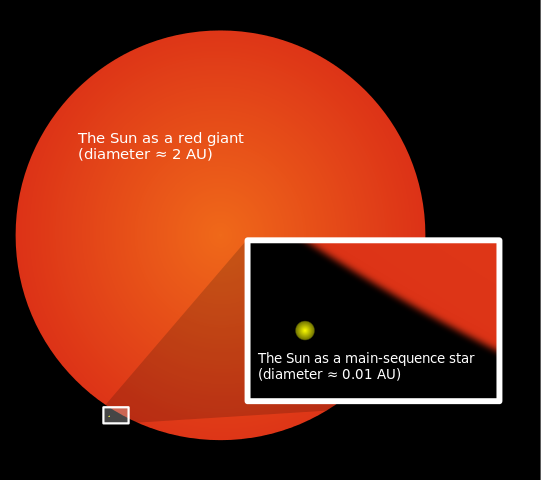</center> <center><sup>Relative size of the Sun as it is now (inset) compared to its estimated future size as a red giant. [Oona Räisänen (User:Mysid), User:Mrsanitazier. • CC-BY-SA-3.0](https://commons.m.wikimedia.org/wiki/File:Sun_red_giant.svg#mw-jump-to-license)</sup></center> <p>Just as I mentioned in my previous post, the <i>mass</i> of an astronomical object can be calculated from the period of any object that is in orbit round it. The <i>diameter</i> of the Sun can be measured from its angular diameter and the value of the astronomical unit (AU). This measurement gives us a solar radius of the visible sphere, the <b>photosphere</b> of 7 ×10<sup>8</sup> m. </p><h4>Let's assume you are required to calculate the average density of the Sun.</h4> To know the average density of the Sun, one needs to consider the average radius of the Sun which is 7 ×10<sup>8</sup> m, so its volume is: <h4><center>v = (4/3)πr<sup>3</sup> = (4/3) × π × (7 ×10<sup>8</sup>)<sup>3</sup> = 1.4 × 10<sup>27</sup>m<sup>3</sup></center></h4> Its mass is 2.0 x 10<sup>30</sup>kg, so its density is: <h4><center>ρ = mass/volume = 2.0 x 10<sup>30</sup>kg/1.4 × 10<sup>27</sup>m<sup>3</sup> = 1.4 × 10<sup>3</sup>kgm<sup>-3</sup></center></h4> This is a little greater than the density of water. <h3><center>THE LUMINOSITY OF THE SUN AND THE SOLAR CONSTANT</center></h3> Luminosity <i>L</i> is a measure of the total radiation energy emitted by a star. At the distance of Earth's orbit, we measure the incident solar radiation energy to be 1.370 kJ per square metre per second (or W m<sup>-2</sup>). This quantity is called the <b>solar constant</b> S. Some energy is absorbed in the atmosphere, so less than this quantity actually reaches the Earth's surface. <center>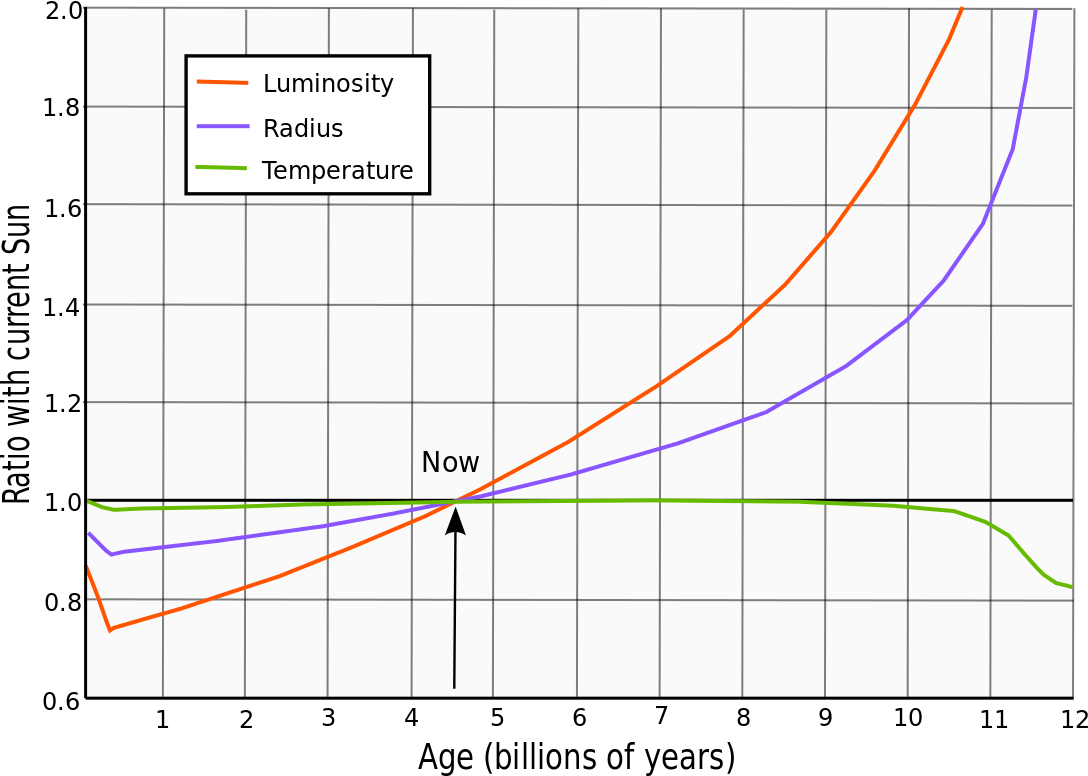.svg.png)</center> <center><sup>Evolution of the solar luminosity, radius and effective temperature compared to the present-day Sun. [Wikimedia, RJHall • CC BY-SA 3.0](https://commons.m.wikimedia.org/wiki/File:Solar_evolution_(English).svg#mw-jump-to-license)</sup></center> <p>The Sun radiates evenly in all directions and so the radiation obeys an inverse square law. Its intensity <i>I</i> is inversely proportional to the square of the radius.</p> <p>The total radiation energy emitted by the Sun passes through a sphere of radius R at the distance of the Earth (1 AU) at the rate of 1.370 x 10<sup>3</sup> W m<sup>-2</sup>. We can therefore calculate the total radiation energy emitted by the Sun as 4πR<sup>2</sup>S where R is 1 AU (1.496 x 10<sup>11</sup> m).</p> <p>This value of luminosity may be used to calculate the Sun's surface temperature T, assuming that it obeys the Stefan-Boltzmann radiation law: </p><h4><center>L = αAT<sup>4</sup> = 4πR<sub>s</sub><sup>2</sup>αT<sup>4</sup></center></h4> where R<sub>s</sub>, is the radius of the Sun, A is its surface area and α is the Stefan-Boltzmann constant, 5.57 x 10<sup>-8</sup> W m<sup>-2</sup>K<sup>-4</sup>. <p>In my next post, I shall be discussing about the Sun in details: its formation, as an energy source and its fusion reactions. Till then, I remain my humble self, @emperorhassy. </p> <h2>Thanks for reading.</h2>  <div class="phishy"><h3>REFERENCES</h3></div> • [How Was the Solar System Formed? - The Nebular Hypothesis ... https://www.universetoday.com › ...](https://www.google.com/url?sa=t&source=web&rct=j&url=https://www.universetoday.com/38118/how-was-the-solar-system-formed/amp/&ved=2ahUKEwj2gd_5zoTiAhVkShUIHaTsB1kQFjASegQICBAB&usg=AOvVaw1w4g5GZ0T75blGv3exj0KP&cf=1) • [Solar system formation by accretion has no observational ... PDFhttps://creation.com › images › pdfs](https://www.google.com/url?sa=t&source=web&rct=j&url=https://creation.com/images/pdfs/tj/j24_2/j24_2_87-94.pdf&ved=2ahUKEwj2gd_5zoTiAhVkShUIHaTsB1kQFjAQegQIARAB&usg=AOvVaw2HaIGCL1gRV_p2Ihkhpozq) • [How Did the Solar System Form? | Space https://www.space.com › 35526-...](https://www.google.com/url?sa=t&source=web&rct=j&url=https://www.space.com/amp/35526-solar-system-formation.html&ved=2ahUKEwj2gd_5zoTiAhVkShUIHaTsB1kQFjAOegQIBhAC&usg=AOvVaw1JxZzRI6AaJ3Vn-6mkZUcB&cf=1) • [Evidence that Jupiter is the oldest planet in the solar system https://phys.org › news › 2017-0...](https://www.google.com/url?sa=t&source=web&rct=j&url=https://phys.org/news/2017-06-evidence-jupiter-oldest-planet-solar.amp&ved=2ahUKEwj2gd_5zoTiAhVkShUIHaTsB1kQFjAMegQIBxAB&usg=AOvVaw3KZ9C_BWPoONncObiZaegS&cf=1) • [Web results Formation and evolution of the Solar System - Wikipedia https://en.m.wikipedia.org › wiki › Form...](https://www.google.com/url?sa=t&source=web&rct=j&url=https://en.m.wikipedia.org/wiki/Formation_and_evolution_of_the_Solar_System&ved=2ahUKEwj2gd_5zoTiAhVkShUIHaTsB1kQFjAKegQIAhAB&usg=AOvVaw1KzMxwTkPfqZsiUFqC1BCn) • [History of Solar System formation and evolution hypotheses ...](https://www.google.com/url?sa=t&source=web&rct=j&url=https://en.m.wikipedia.org/wiki/History_of_Solar_System_formation_and_evolution_hypotheses&ved=2ahUKEwj2gd_5zoTiAhVkShUIHaTsB1kQFjABegQIDxAE&usg=AOvVaw0OATIHVv5gnu9JsmTt_RQR) • [origin and evolution of the solar system | Astronomy & Geophysics | Oxford ... https://academic.oup.com › article](https://www.google.com/url?sa=t&source=web&rct=j&url=https://academic.oup.com/astrogeo/article/41/1/1.12/182262&ved=2ahUKEwiRn6L70ITiAhWkA2MBHezSAdsQFjAhegQIBxAB&usg=AOvVaw1inPUJsopzRpK28Scr_Pxx) • [Planet formation and the evolution of the Solar System - arXiv PDFhttps://arxiv.org › pdf](https://www.google.com/url?sa=t&source=web&rct=j&url=https://arxiv.org/pdf/1709.07294&ved=2ahUKEwiRn6L70ITiAhWkA2MBHezSAdsQFjAgegQIBhAB&usg=AOvVaw0L3kuBxhZgvLP4eRJKxtpa) • [Formation and Evolution of the Solar System | Astronomy 801: Planets ... https://www.e-education.psu.edu › node](https://www.google.com/url?sa=t&source=web&rct=j&url=https://www.e-education.psu.edu/astro801/node/2076&ved=2ahUKEwiRn6L70ITiAhWkA2MBHezSAdsQFjAfegQIBRAB&usg=AOvVaw2v8CDNDMXZn7N0DR_U_wGR) • [Solar System Evolution: Peering Back at the Sun's Cosmic Womb | Space https://www.space.com › 26762-...](https://www.google.com/url?sa=t&source=web&rct=j&url=https://www.space.com/amp/26762-solar-system-evolution-sun-formation.html&ved=2ahUKEwiRn6L70ITiAhWkA2MBHezSAdsQFjAdegQIBBAB&usg=AOvVaw1owu_B-jd4t7B447ptkle_&cf=1) • [Formation and Evolution of the Solar System - Oxford Research ... planetaryscience.oxfordre.com › acrefore](https://www.google.com/url?sa=t&source=web&rct=j&url=http://planetaryscience.oxfordre.com/view/10.1093/acrefore/9780190647926.001.0001/acrefore-9780190647926-e-2&ved=2ahUKEwiRn6L70ITiAhWkA2MBHezSAdsQFjAcegQIARAB&usg=AOvVaw0-LgBnoJ-mm9QGF3pn_WXy) • [How Was the Solar System Formed? - The Nebular Hypothesis ... https://www.universetoday.com › ...](https://www.google.com/url?sa=t&source=web&rct=j&url=https://www.universetoday.com/38118/how-was-the-solar-system-formed/amp/&ved=2ahUKEwj2gd_5zoTiAhVkShUIHaTsB1kQFjASegQICBAB&usg=AOvVaw1w4g5GZ0T75blGv3exj0KP&cf=1) • [Solar system formation by accretion has no observational ... PDFhttps://creation.com › images › pdfs](https://www.google.com/url?sa=t&source=web&rct=j&url=https://creation.com/images/pdfs/tj/j24_2/j24_2_87-94.pdf&ved=2ahUKEwj2gd_5zoTiAhVkShUIHaTsB1kQFjAQegQIARAB&usg=AOvVaw2HaIGCL1gRV_p2Ihkhpozq)  <p><sub>Make sure to follow steemstem on <a href="https://www.steemstem.io/#!/@steemstem" target="_blank" rel="noopener"><strong>steemstem.io</strong></a>, <a href="https://steemit.com/@steemstem" target="_blank" rel="noopener"><strong>steemit</strong></a>, <a href="https://www.facebook.com/OfficialsteemSTEM/" target="_blank" rel="noopener"><strong>facebook</strong></a>, <a href="https://twitter.com/steemstem_" target="_blank" rel="noopener"><strong>twitter</strong></a>, and <a href="https://www.instagram.com/steemstem/" target="_blank" rel="noopener"><strong>instagram</strong></a> to always be up-to-date on our latest news and ideas.</sub></p> <p><sub>Please also consider to support the project by <strong>delegating to @steemstem</strong> for a ROI of 65% of our curation rewards (quick delegation links: <a href="https://steemconnect.com/sign/delegateVestingShares?delegator=&delegatee=steemstem&vesting_shares=50%20SP" target="_blank" rel="noopener">50SP</a> | <a href="https://steemconnect.com/sign/delegateVestingShares?delegator=&delegatee=steemstem&vesting_shares=100%20SP" target="_blank" rel="noopener">100SP</a> | <a href="https://steemconnect.com/sign/delegateVestingShares?delegator=&delegatee=steemstem&vesting_shares=500%20SP" target="_blank" rel="noopener">500SP</a> | <a href="https://steemconnect.com/sign/delegateVestingShares?delegator=&delegatee=steemstem&vesting_shares=1000%20SP" target="_blank" rel="noopener">1000SP</a> | <a href="https://steemconnect.com/sign/delegateVestingShares?delegator=&delegatee=steemstem&vesting_shares=5000%20SP" target="_blank" rel="noopener">5000SP</a> | <a href="https://steemconnect.com/sign/delegateVestingShares?delegator=&delegatee=steemstem&vesting_shares=10000%20SP" target="_blank" rel="noopener">10000SP</a>).</sub></p> <p><sub><a href="https://steemit.com/@steemstem" target="_blank" rel="noopener">Follow us</a> || <a href="https://steemconnect.com/sign/account_witness_vote?approve=1&witness=stem.witness" target="_blank" rel="noopener">Vote for the SteemSTEM Witness</a> || <a href="https://www.steemstem.io" target="_blank" rel="noopener">Visit our new home steemstem.io</a></sub></p>  </div> ## <center>Steem on; Oh ye of great minds!</center>   <sub>Image credit: @hightouch</sub>
👍 votes4minnows, millibot, jadabug, trenz, ezravandi, accelerator, hdu, imisstheoldkanye, steemexpress, beetlevc, bukiland, rhampagoe, bluesniper, zugs, itarowo, minminlou, edengond, suprenoon, ustil, enginom, ederonde, cissofai, utadingot, drunktrader, hototon, utouti, panio1, ontore8, pinceyse, routhengu, oyindim, aneriss, ownea, nadit, ahruprof, ronenievo, uldomyo, ampilem, cerit2, lulda, ustaris, atongare, adatigetu, rangurom, tiganedy, etimofus, tutordu, koorsicu, bindelam, endeseror, yentimyal, pagliozzo, naritedo, rerata, lalaso, petyaxxx, tarea, illedra, itondenga, erinesine, edour2, dumuteedd, nuliteric, ilfeelyio, ederer, ofrindou, ingutsad, uparyouro, ereran, adedasas, idama, atoninorn, entonesti, loorsun, amsisis, ilyin, orend, esilesti, simplepim, ishac, oredonere, eloryowou, yomilt, rouci, masleayi, maros3, yesse8, sathecumi, bomjara, utashed, aleat, ithenor, ofrit, reamson, tyzone, onoras, engistor, tiseser, yerac, turisted, asowesola, disase, gitriof, edsile, ifof, oyomardo, dianna1, relomit, rorso, dadradr, itistin, ondat, iratomi, sengel, astoureng, nedontil, tikk, sesurick, ilered, istill, ugonet, inditong, biggangbang, untenofi, rienidl, edespess, ratondofi, simponoo, nonderi, alluraste, onsime, upayi, intorall, utedserof, ororout, secessexc, syan, nasdaq.analitizz, talanke, utoosi, eloumya, pirtes, narcon, simadrupr, endisinsa, blockchaingame, krish14, vallo, purnoorn, lontesl, ogerado, ishuporm, itameto, sanan, ofesti, ilerome, erongise, yelee, arengic, risere, peert, bass-boost, eritedede, ritongath, yandern, neattor, setlaldel, ortel, tupala, raloflo, tessurat, arablonti, angoses, tethore, sered, ayiert, reseden, tilla8, acaredrer, edyaimire, teratin, entowai, gudiya2, carongeda, teckothes, useded, erteane, inenend, uparo, vuecrof, edidrasa, anins, issomiont, iladondu, titim9, rease, otindim, orisen, ondomb, hasenga, angofes, yabloko, nuren1, sarasto, lasilari, aqurar, essens, stableman, athererer, eproomsa, ererin, usonc, rarso, tererall, sigar, loffut, watanedo, dream.frend, sorsurte, tororar, entashant, toowadd, tusowea, desong, lutansun, disowhow, edoresene, utari1, inetimi, herindist, athate, erisu, sofat, anowedo, egrisp, ensacesto, delbel, resubrig, arale4, eliler, edseco, amunsuch, dahyorom, omyon, cactilesa, inoushi, utcipio, jameriska, alyishily, lasorte, oncow, fararlue, ironkosa, yiomuc, espoces, woostasu, ondurs, otest, itongaser, poulofrou, taimm, owhen, talis4, seratora, dendedou, terenton, uculadro, emperorhassy, greenrun, gentleshaid, steemstem, dna-replication, alexzicky, ascorphat, curie, nunesso, pflanzenlilly, kjaeger, suesa, jasonbu, coolbuddy, erikkun28, aalok, mattiarinaldoni, bobandtom, intellihandling, emmanuel293, cryptofuwealth, alexworld, doneliseo, kingnosa, cameravisual, amin-ove, huilco, cerd26, donasys, sapphire.app, atomicannie, faberleggenda, mohaaking, gustavoagt, vaccinusveritas, celine-robichaud, kevinwong, lemouth, locikll, robotics101, rionpistorius, scoora82, effofex, count-antonio, alexander.alexis, fancybrothers, howo, tuoficinavirtual, tanyaschutte, felixrodriguez, felicenavidad, mayowadavid, shivagangula, bitinvdig0, tristan-muller, fejiro, sco, adetola, rharphelle, shoganaii, jlmol7, real2josh, traviseric, trixie, kingabesh, dedesuryani, de-stem, magatha, temitayo-pelumi, beautyinscience, casiloko, scottallen, moniroy, praditya, lorasia, gutenmorganism, sembdelgado, vact, bloom, helo, samminator, tsoldovieri, hotsteam, esteemguy, mr-aaron, kenadis, maticpecovnik, terrylovejoy, olajidekehinde, dexterdev, alexdory, flugschwein, francostem, derbesserwisser, michaelwrites, deholt, marcuz, ibk-gabriel, purelyscience, wstanley226, jrevilla, javier.dejuan, stem.witness, andiblok, diebaasman, abigail-dantes, reaverza, gra, pinksteam, stemng, geopolis, lesmouths-travel, kingabesh1, jent, chrisluke, tggr, jesse5th, suesa-random, mondodidave73, mtfmohammad, mrnightmare89, cryptokrieg, naturalproducts, aboutyourbiz, howtostartablog, gambit.coin, phogyan, speaklife, admiralsp, makrotheblack, markmorbidity, esaia.mystic, strings, loydjayme25, morbyjohn, bil.prag, hendrikdegrote, dashfit, muliadi, debbietiyan, lovetouch, beni96, anwenbaumeister, nitego, leyla5, jpmkikoy, phaazer1, tombstone, arconite, derekvonzarovich, sireh, operahoser, hiddenblade, niouton, schroders, carolynseymour, mountain.phil28, clweeks, gotgame, digitalpnut, monie, beladro, croctopus, jaycem, kendallron, ntowl, qberryfarms, doctor-cog-diss, saarah, steemzeiger, biomimi, testomilian, raymondspeaks, thatsweeneyguy, szokerobert, jayna, corsica, zonguin, kingswisdom, irishcoffee, paddygsound, joendegz, mhm-philippines, darkiche, dragibusss, galam, hansmast, moksamol, getrichordie, samest, agbona, stahlberg, the.chiomz, teekingtv, joelagbo, djoi, bavi, davidcentenor, menoski, onethousandpics, thurllanie, steemituplife, sciencetech, rocketpower, kimchi-king, didic, ashfaaaq, teemike, resteemer, nolasco, neumannsalva, poodai, drmake, tomatom, asonintrigue, technotroll, avizor, call-me-howie, whoib, akumar, irisworld, ameliabartlett, nigerian-yogagal, disruptivas, clement.poiret, kiikoh, gangstayid, gabrielatravels, galione, deividluchi, raghao, rhethypo, antigourmet, predict-crypto, delegate.lafona, idkpdx, ilovecryptopl, momimalhi, yaelg, chickenmeat, lola-carola, psygambler, gmedley, click3rs, mininthecity, cjunros, ejgarcia, zerokun, semtroneum, slickhustler007, stonecoin, andydream, alom8, positiveninja2, lenin-mccarthy, boynashruddin, alexanderrigov, hectgranate, pechichemena, venalbe, reizak, zlatkamrs, lilianajimenez, adalhelm, positiveninja, lilacse, annaabi, ananas.studio, zeldacroft, sarhugo, rasalom, expanse, jan-mccomas, theironfelix, riche-gould, jlsplatts, abeyaimary, brutledge, gordon92, jordan.white306, payger, elsll, naomipangolin, blewitt, scrawly, bflanagin, shadown99, trang, eu-id, juliamulcahy, lekang, dokter-purnama, jakesdewet, florian-glechner, teukurival, onemedia, mladenpaunovic, talli-art, jcalero, pg-live-pt, outtheshellvlog, edanya, somegaming, velmafia, homefree, solarphasing, splatz, networker5, goldkeys, allcapsonezero, revo, eurodale, shayekh2, gerel, kothy, ambitiouslife, jingis07, gabyoraa, berien, partitura, anti-bully, reverseacid, cowpatty, priyankachauhan, ratspencer, luiyi-22, jk6276.mons, tonyudo57, patris, zerotoone, tensor, cryptononymous, letsplaywhatelse, wales, plgonzalezrx8, cryptocopy, shortsegments, ambercookie, aniita, cyberdyn, nicephoto, epic4chris, begood2me, lil-splatts, sivehead, splatz-1, theinspiration, serylt, perpetuum-lynx, fanta-steem, dbddv01, zest, bohemian.machine, steinz, jewlzie, zackarie, communityisyou, pamahdoo, kipswolfe, stem-espanol, giuato, smacommunity, lorenzor, iamphysical, azulear, carloserp-2000, ivymalifred, vjap55, yrmaleza, miguelangel2801, emiliomoron, tomastonyperez, elvigia, luiscd8a, elpdl, josedelacruz, joseangelvs, viannis, majapesi, erickyoussif, yusvelasquez, mirzantorres, ubaldonet, mary11, reinaseq, lupafilotaxia, fran.frey, alfonzoasdrubal, giulyfarci52, wilmer14molina, ydavgonzalez, andrick, joannar, descalante, paradigmprospect, alaiza, lapp, steemtpistia, crassipes, agrovision, peaceandwar, bitcoinportugal, psicoluigi, medicnet, thescubageek, mahdiyari, lamouthe, vodonik, cyprianj, eniolw, lmon, longer, imaloser, cjmoney, t750, cojp, wackou, drifter1, iansart, onartbali, thomaskatan, blockurator, drifter2, diyanti86, kanhiyachauhan, raoufwilly, alvin0617, electrodo, jiujitsu, gio6, vegan.niinja, gracelbm, knightbjj, deadcountry, combatsports, sirjaxxy, danaedwards, shinedojo, wrestletalk, landria, opheliapoe, damzxyno, massivevibration, bennettitalia, rival, happychild, benleemusic, gribouille, drsensor, lacher-prise, eric-boucher, robertbira, eliaschess333, eroticabian, sanderdieryck, eurogee, yomismosoy, alex-hm, nicole-st, amestyj, laurentiu.negrea, acont, hhtb, kafupraise, goodway, egotheist, langford, steepup, lk666, cooknbake, hillaryaa, delph-in-holland, xanderslee, cordeta, christianyocte, mrxplicit, ivan-g, sunshinebear, apteacher, flatman, marehalm, senorcoconut, oghie, gosmire78, oclinton, danlipert, wargof, guga34, carlos84, sandracarrascal, ennyta, gaming.yer, steem-familia, evangelista.yova, jenniferjulieth, ajfernandez, endopediatria, ingmarvin, alix96, elimao, anaestrada12, yorgermadison, alexjunior, antunez25, haf67, chavas, uzcateguiazambra, douglimarbalzan, eglinson, asmeira, garrillo, pfernandezpetit, mgarrillogonzale, rubenp, jeferc, hirally, emynb, eugenialobo, ballesteroj, jcmontilva, rodriguezr, marbely20, moyam, emilycg, darys, balcej, lmanjarres, anaka, benhurg, judisa, juddarivv, mariamo, kimmorales, loraine25, sibaja, jonmagnusson, musicvoter, infamousit, wolfnworbeikood, newenx, musiciansupport, isaria, archaimusic, lillywilton, emsteemians, andohyara, edprivat, lionsmane, utopian-io, cryptouno, jga, sargoon, dicetime, chappertron, crazy-facts, irelandscape, klein7,